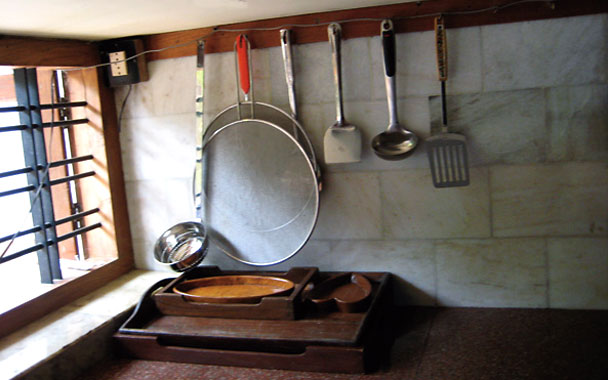I had been in the country for almost two weeks before I made my way to the sun-dappled kitchen at Philipkutty’s Farm. This family-owned “homestay” occupies a good bit of an obscure island off India’s southwestern flank—which, in a more romantic era, was named the Malabar Coast. Aniamma Philip (called “Mummy” by absolutely everyone), who runs the inn with her daughter-in-law, Anu Mathew, and conducts cooking classes, was making a fish curry, redolent of onions, green chiles, ginger, and garlic. Before I passed her a bouquet of curry-leaf sprigs, I breathed in their distinct scent. At once musky and citrus-bright, the leaves, which don’t have anything to do with the British invention called curry powder, come from a shrubby tree and are a hallmark of this region’s food. When new guests arrived early, Mummy quickly organized a tray of glasses filled with a ginger-lime cooler and, with a practiced flick of her cream-colored sari, swept off to greet them.
Alone for the first time in an Indian home kitchen, I peered into the uruli, which is about a foot and a half wide and six inches deep. I stirred the onions so that they would soften without browning, then I stripped the curry leaves from their stems and tossed them in. (Though I already had a working familiarity with South Indian ingredients and techniques, I’d come here to explore the cuisine and the culture more deeply.) Mummy returned, added three dollops of chile paste—chile powder, ground coriander, and turmeric mixed with just enough water—to the pot, scooped up more glasses of ginger-lime, and departed. I knew the spices needed time to blend and mellow, so I drifted over to the door. A stone’s throw away, inside the freestanding screened-in prep kitchen, a wood fire burned steadily—that was to cook rice for the workers’ meal—and someone was bent over a flat grinding stone, probably pulverizing coconut, another staple. A man carrying a machete and a stalk of bananas stepped around the corner of the house, startling a kingfisher, which darted by, inches from my nose, in a brilliant flash of blue. Mummy materialized again and added chunks of a white ocean fish to the fragrant, deep red sauce. After a moment, she picked up the uruli and swirled the sauce to evenly distribute the heat without breaking up the pieces of fish.
It was Mummy’s father who reclaimed this island from the Backwaters—an intricate, silvery maze of lakes, creeks, marshes, and canals that separates this part of Kerala from the Arabian Sea. Her late husband grew coconuts here, and her son—Anu’s husband, who died unexpectedly two years ago—built five charming canal-front villas for guests. In the slanting light of late afternoon, the waterway is testimony to a placid, amphibious way of life. The country boats called vallams transport everything from coir and spices to schoolchildren in plaid uniforms, who wave as they go by. Fishermen in dugout canoes hoist rag sails to get home in time for supper. Tourists loll on the jackwood decks of the kettu vallams, or houseboats, which have become big business. Venture down the smaller tributaries, and you’ll find an enduring domestic scene: Each sliver of land holds a tiny house, a few chickens, perhaps a caramel-colored cow tethered to a mango tree. On the far side are paddy fields, where each seedling is blessed before being planted. The people here live their philosophies, their religions.




 Pinterest
Pinterest






